Study on Dehumidification Performance of a Multi-Stage Internal Cooling Solid Desiccant Adsorption Packed Bed
Abstract
:1. Introduction
2. System Description
3. Construction of the Testing Rig
3.1. Testing Rig
3.2. Test Methods and Conditions
4. Analysis and Discussion
4.1. Dehumidification Capacity
4.2. Dehumidification Efficiency
4.3. Water Content
4.3.1. Water Content of the Whole Dehumidification Device
4.3.2. Water Content of Each Stage
4.4. Moisture Ratio
4.4.1. Moisture Ratio of the Whole Dehumidification Device
4.4.2. The Moisture Ratio of Each Stage
4.5. The Temperature of Solid Desiccant
4.5.1. The Average Temperature of the Whole Dehumidification Device
4.5.2. The Average Temperature of Each Stage
4.6. Temperature Difference between the Inlet and Outlet Air
5. Dehumidification Calculation Model
5.1. Mass Balance
- The water content of the desiccant in the axial gradient can be neglected.
- The solid desiccant and the exit air of the dehumidification module are mass equilibrium.
- Isothermal adsorption is achieved in the dehumidification process.
- The average volume of air is used to simulate the mass transfer process.
5.2. Energy Balance
6. Conclusions
- The internal cooling adsorption bed could improve the dehumidification efficiency effectively. It was more obvious in low temperature and low humidity conditions than in hot and humid. It could also be obtained with the use of free-cooling [25], refrigerators with new thermoacoustic technology [26], or the use of “Smart-windows” [27], for reducing the thermal required load.
- Water temperature has a great influence on the dehumidification effect. The lower the temperature of water, the more the dehumidification efficiency improves. For the ICSPB operating under the inlet air temperature of 20 °C and relative humidity of 55%, the dehumidification efficiency could be improved by 59.69% and 39.32% with cold water of 14 °C and 18 °C supplying to the heat exchangers respectively, for this purpose, geothermal heat pumps [28] could be used.
- Under the condition of low temperature and humidity, the utilization ratio of the solid desiccant with internal cooling was 1.2–1.5 times that of non-internal cooling test conditions in the effective dehumidification time.
- The outlet air temperature could be reduced by 14 °C maximally compared with that without internal cooling when the ICSPB operated at the inlet air temperature of 34 °C, relative humidity of 68% and water temperature of 28 °C. So that the sensible heat load could be reduced, and special heat recovery units [29] could be used.
- In the multi-stage dehumidification bed, the first stage adsorption bed played the most important role.
Author Contributions
Funding
Conflicts of Interest
Nomenclature
| A | cross-sectional area, m2; |
| C | perimeter of air flow passage, m; |
| c | specific heat, kJ/kg K; |
| d | humidity ratio, g water/kg dry air; |
| G | mass flux, kg/m2 s; |
| K1 | regression constant depending on the inlet air temperature; |
| K2 | regression constant depending on the inlet air temperature; |
| h | heat transfer coefficient, kW/m2 K; |
| hm | mass transfer coefficient, kg/m2 s; |
| HA | adsorption heat, kJ/kg; |
| L | thickness of solid desiccant, m; |
| m | mass of the desiccant, kg; |
| MR | moisture ratio; |
| Re | Reynolds number; |
| T | temperature, °C; |
| u | velocity of the air, m/s; |
| w | water content ratio, kg water/kg dry silica; |
| τ | time, h; |
| ρ | density, kg/m3; |
| η | dehumidification efficiency, %; |
| ε | fractional void volume; |
| β | constant; |
| Subscript | |
| 0 | initial condition; |
| a | air; |
| e | final condition; |
| in | inlet; |
| out | outlet; |
| s | solid desiccant; |
| w | water |
References
- Hu, L.M.; Ge, T.S.; Jiang, Y.; Wang, R.Z. Performance study on composite desiccant material coated fin-tube heat exchangers. Int. J. Heat Mass Transf. 2015, 90, 109–120. [Google Scholar] [CrossRef]
- Jani, D.B.; Mishra, M.; Sahoo, P.K. Solid desiccant air conditioning—A state of the art review. Renew. Sustain. Energy Rev. 2016, 60, 1451–1469. [Google Scholar] [CrossRef]
- Yeboah, S.K.; Darkwa, J. A critical review of thermal enhancement of packed beds for water vapour adsorption. Renew. Sustain. Energy Rev. 2016, 58, 1500–1520. [Google Scholar] [CrossRef]
- Gandhidasan, P.; Al-Farayedhi, A.A.; Al-Mubarak, A.A. Dehydration of natural gas using solid desiccants. Energy 2001, 26, 855–868. [Google Scholar] [CrossRef]
- Golubovic, M.N.; Hettiarachchi, H.D.M.; Worek, W.M. Sorption properties for different types of molecular sieve and their influence on optimum dehumidification performance of desiccant wheels. Int. J. Heat Mass Transf. 2006, 49, 2802–2809. [Google Scholar] [CrossRef]
- Yang, L.J.; Li, W.; Chen, L.N.; Zheng, Q.; Chen, W. Effect of fixed adsorption bed structure on regeneration and dehumidification. J. Refrig. 2015, 36, 101–105. [Google Scholar]
- Ramzy, A.; Abdelmeguid, H.; Elawady, W.M. A novel approach for enhancing the utilization of solid desiccants in packed bed via intercooling. Appl. Therm. Eng. 2015, 78, 82–89. [Google Scholar] [CrossRef]
- Hung, B.N.; Nuntaphan, A.; Kiatsiriroat, T. Effect of internal cooling/heating coil on adsorption/regeneration of solid desiccant tray for controlling air humidity. Int. J. Energy Res. 2008, 32, 980–987. [Google Scholar] [CrossRef]
- Yuan, W.X.; Zheng, Y.; Liu, X.; Yuan, X.G. Study of a new modified cross-cooled compact solid desiccant dehumidifier. Appl. Therm. Eng. 2008, 28, 2257–2266. [Google Scholar] [CrossRef]
- Peng, Z.Z.; Dai, Y.J.; La, D.; Wang, R.Z. Transient dehumidification performance of a novel regenerative desiccant heat exchanger. Acta Energiae Sol. Sin. 2011, 32, 530–536. [Google Scholar]
- Ge, T.S.; Dai, Y.J.; Wang, R.Z.; Peng, Z.Z. Experimental comparison and analysis on silica gel and polymer coated fin-tube heat exchangers. Energy 2010, 35, 2893–2900. [Google Scholar] [CrossRef]
- Ge, T.S.; Dai, Y.J.; Li, Y.; Wang, R.Z. Simulation investigation on solar powered desiccant coated heat exchanger cooling system. Appl. Energy 2012, 93, 532–540. [Google Scholar] [CrossRef]
- Ge, T.S.; Dai, Y.J.; Li, Y.; Wang, R.Z. Feasible study of a self-cooled solid desiccant cooling system based on desiccant coated heat exchanger. Appl. Therm. Eng. 2013, 58, 281–290. [Google Scholar] [CrossRef]
- Li, Z.; Michiyuki, S.; Takeshi, F. Experimental study on heat and mass transfer characteristics for a desiccant-coated fin-tube heat exchanger. Int. J. Heat Mass Transf. 2015, 89, 641–651. [Google Scholar] [CrossRef]
- Finocchiaro, P.; Beccali, M.; Gentile, V. Experimental results on adsorption beds for air dehumidification. Int. J. Refrig. 2016, 63, 100–112. [Google Scholar] [CrossRef]
- Cannistraro, M.; Lorenzini, E. The Applications of the New Technologies “E-Sensing” in Hospitals. Int. J. Heat Technol. 2016, 34, 551–557. [Google Scholar] [CrossRef]
- Zhao, Y.; Dai, Y.J.; Ge, T.S.; Wang, H.H.; Wang, R.Z. A high performance desiccant dehumidification unit using solid desiccant coated heat exchanger with heat recovery. Energy Build. 2016, 116, 583–592. [Google Scholar] [CrossRef]
- Zhang, L.Z.; Niu, J.L. Performance comparisons of desiccant wheels for air dehumidification and enthalpy recovery. Appl. Therm. Eng. 2002, 22, 1347–1367. [Google Scholar] [CrossRef]
- Hamed, A.M.; El Rahman, W.R.A.; El-Emam, S.H. Experimental study of the transient adsorption/desorption characteristics of silica gel particles in fluidized bed. Energy 2010, 35, 2468–24837. [Google Scholar] [CrossRef]
- Koua, K.B.; Fassinou, W.F.; Gbaha, P.; Toure, S. Mathematical modelling of the thin layer solar drying of banana, mango and cassava. Energy 2009, 34, 1594–1602. [Google Scholar] [CrossRef]
- Yang, W.S.; Deng, H.; Wang, Z.Y.; Zhao, X.D.; He, S. Performance Investigation of the Novel Solar-Powered Dehumidification Window for Residential Buildings. Energies 2017, 10, 1369. [Google Scholar] [CrossRef]
- Kabeel, A.E. Adsorption–desorption operations of multilayer desiccant packed bed for dehumidification applications. Renew. Energy 2009, 34, 255–265. [Google Scholar] [CrossRef]
- Ramzy, K.A.; Babu, T.P.A.; Kadoli, R. Semi-analytical method for heat and moisture transfer in packed bed of silica gel. Int. J. Heat Mass Transf. 2011, 54, 983–993. [Google Scholar] [CrossRef]
- Pesaran, A.A.; Mills, A.F. Moisture transport in silica gel packed beds—I. Theoretical study. Int. J. Heat Mass Transf. 1987, 30, 1037–1049. [Google Scholar] [CrossRef]
- Cannistraro, G. Reducing the Demand of Energy Cooling in the CED, “Centers of Processing Data”, with Use of Free-Cooling Systems. Int J. Heat Technol. 2016, 34, 498–502. [Google Scholar] [CrossRef]
- Piccolo, A.; Siclari, R.; Rando, F.; Cannistraro, M. Comparative Performance of Thermoacoustic Heat Exchangers with Different Pore Geometries in Oscillatory Flow. Implementation of Experimental Techniques. Appl. Sci. 2017, 7, 784. [Google Scholar] [CrossRef]
- Cannistraro, M.; Castelluccio, M.E.; Germanò, D. New Sol-Gel Deposition Technique in the Smart-Windows—Computation of possible applications of Smart-Windows in Buildings. J. Build. Eng. 2018, 19, 205–301. [Google Scholar] [CrossRef]
- Cannistraro, M.; Mainardi, E.; Bottarelli, M. Testing a dual-source heat pump. Math. Model. Eng. Probl. 2018, 5, 205–210. [Google Scholar] [CrossRef]
- Cannistraro, G.; Cannistraro, M.; Galvagno, A.; Trovato, G. Analysis and measures for energy savings in operating theaters. Int. J. Heat Technol. 2017, 35, S442–S448. [Google Scholar] [CrossRef]

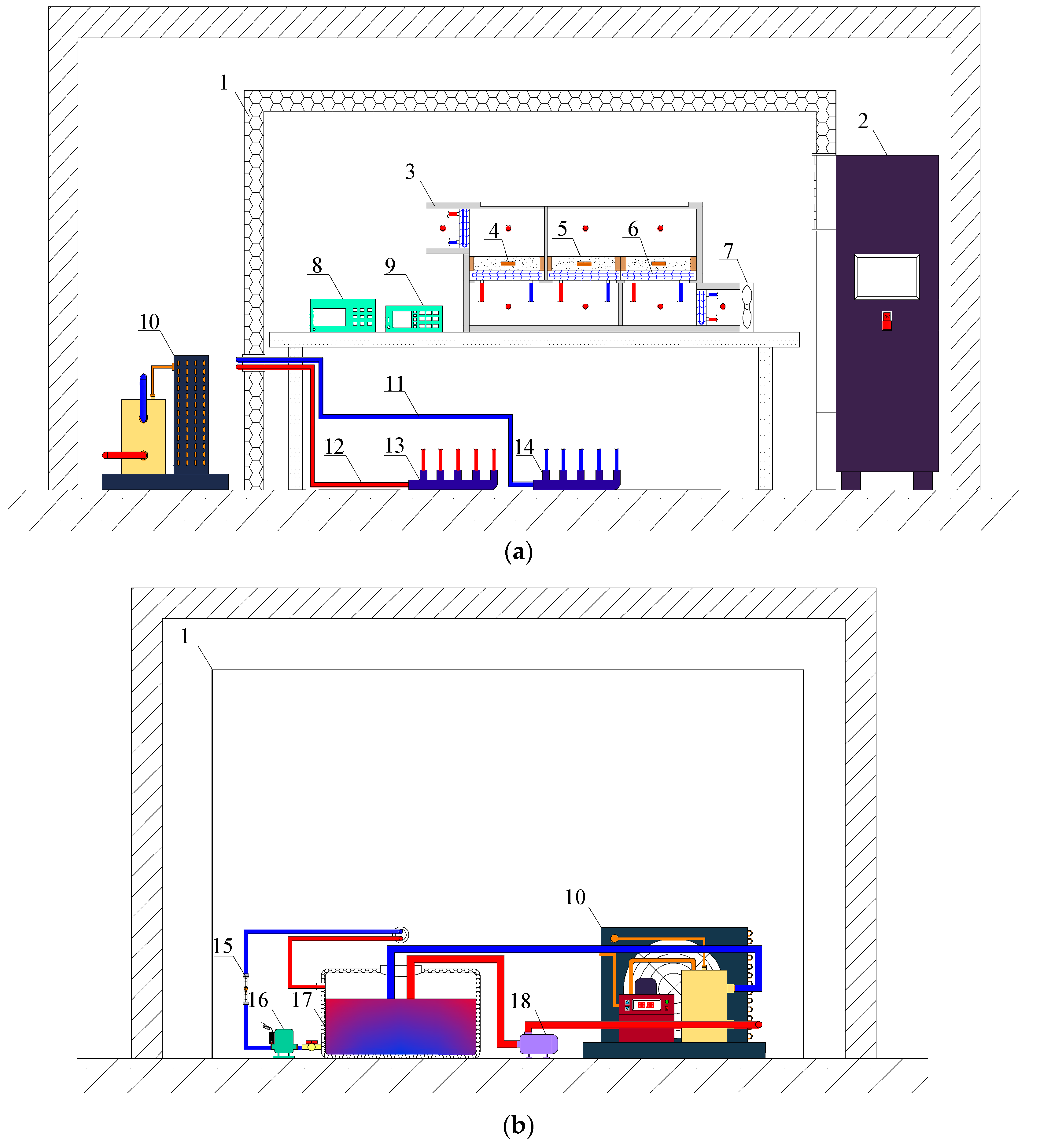
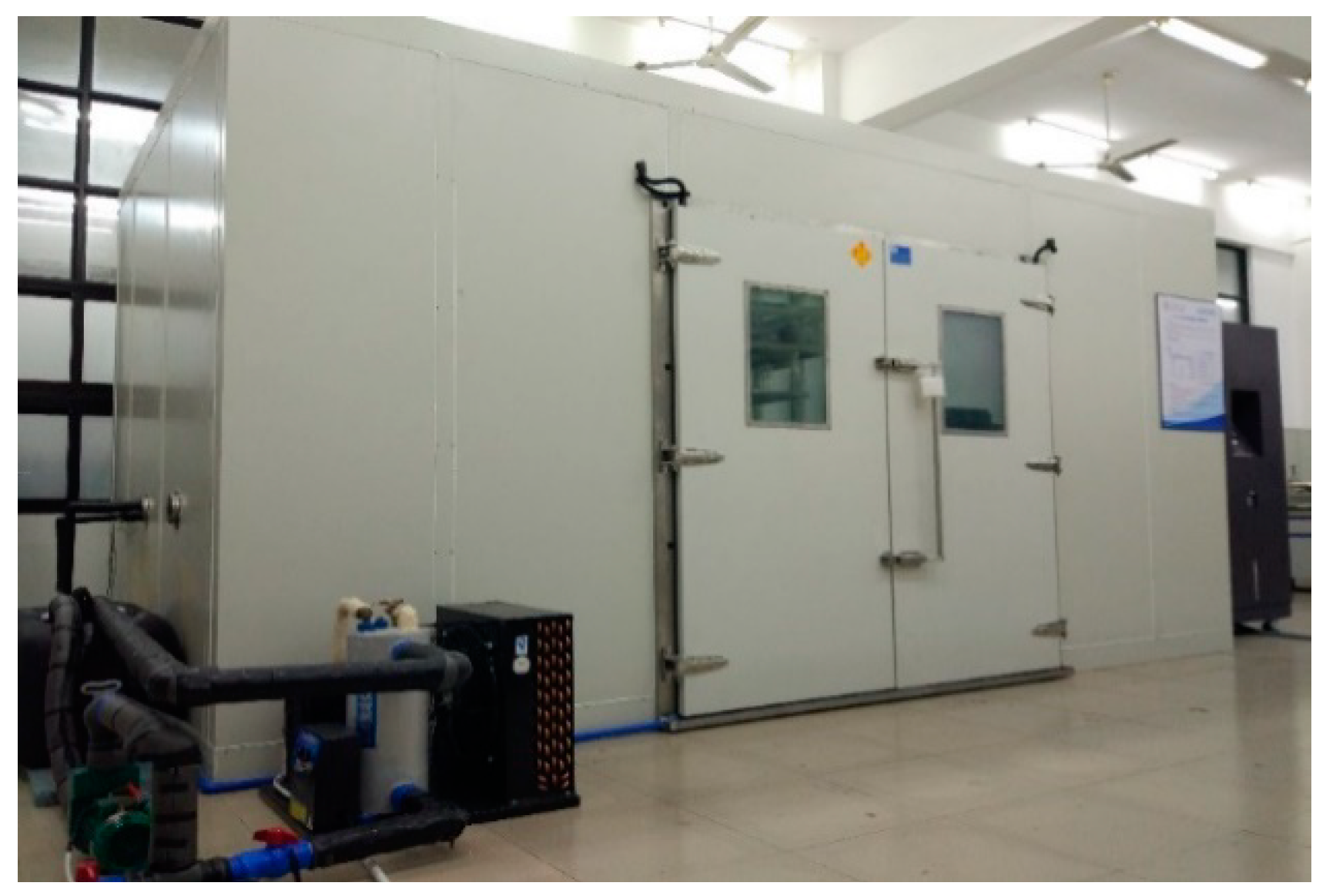
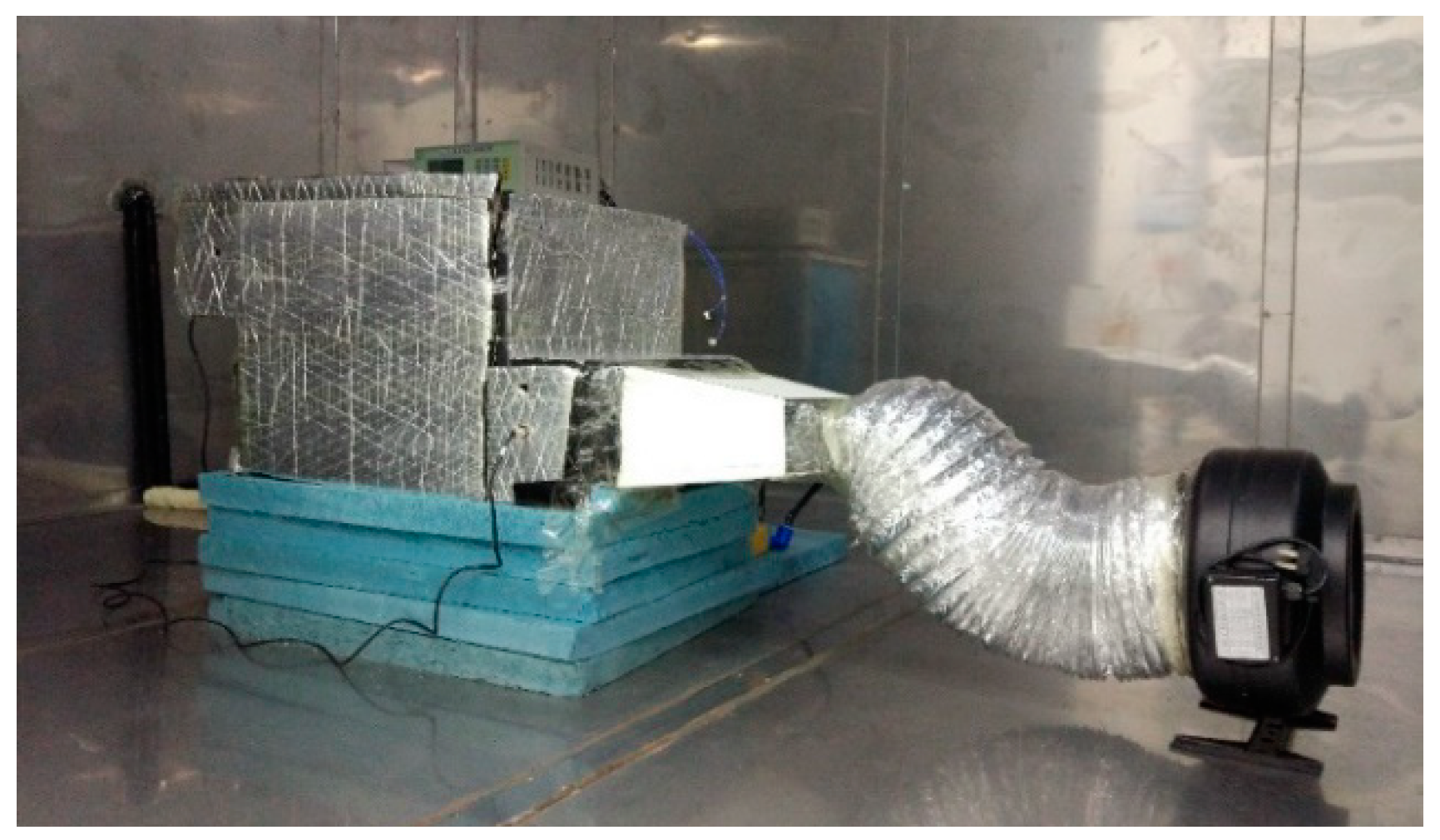
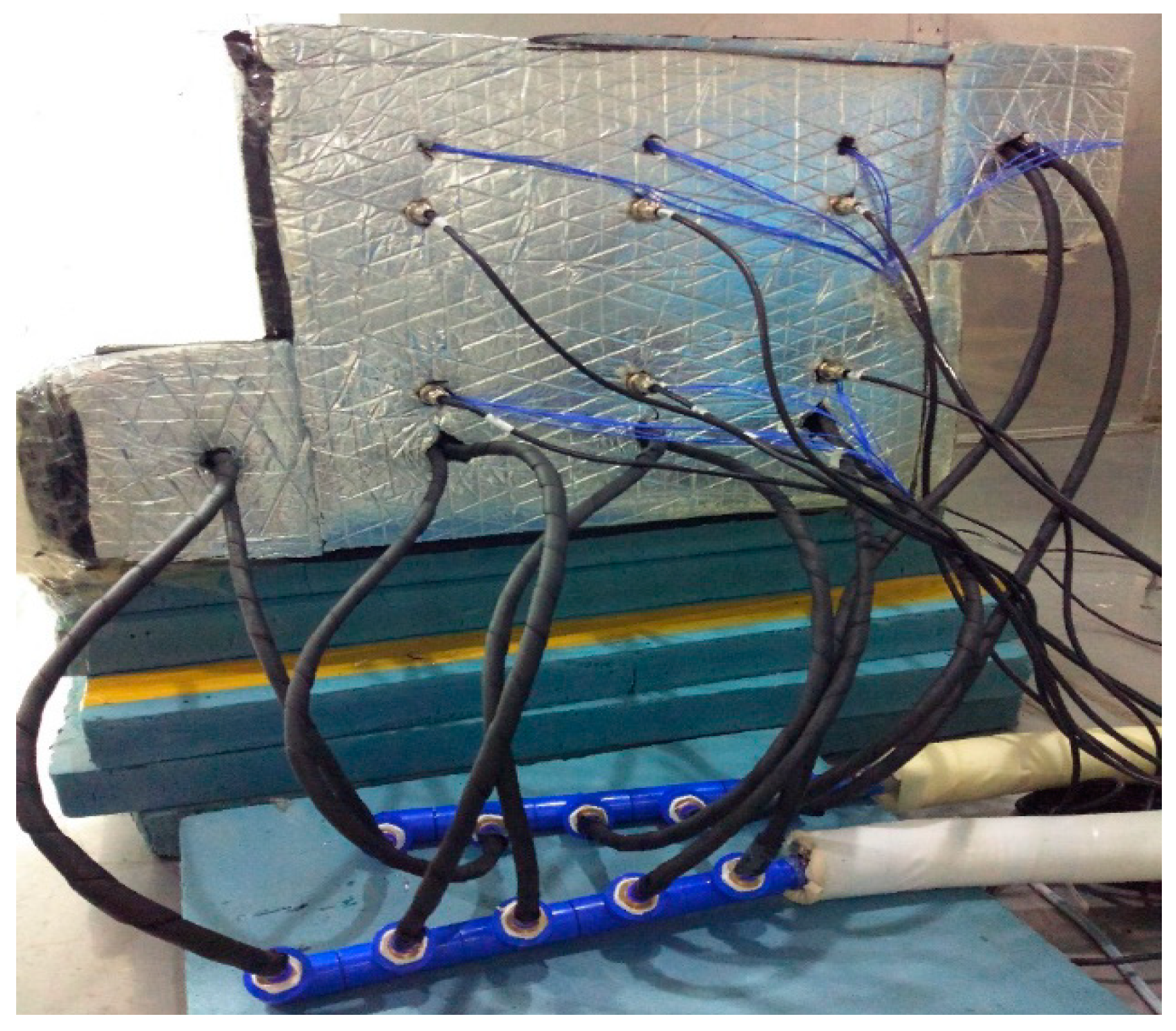

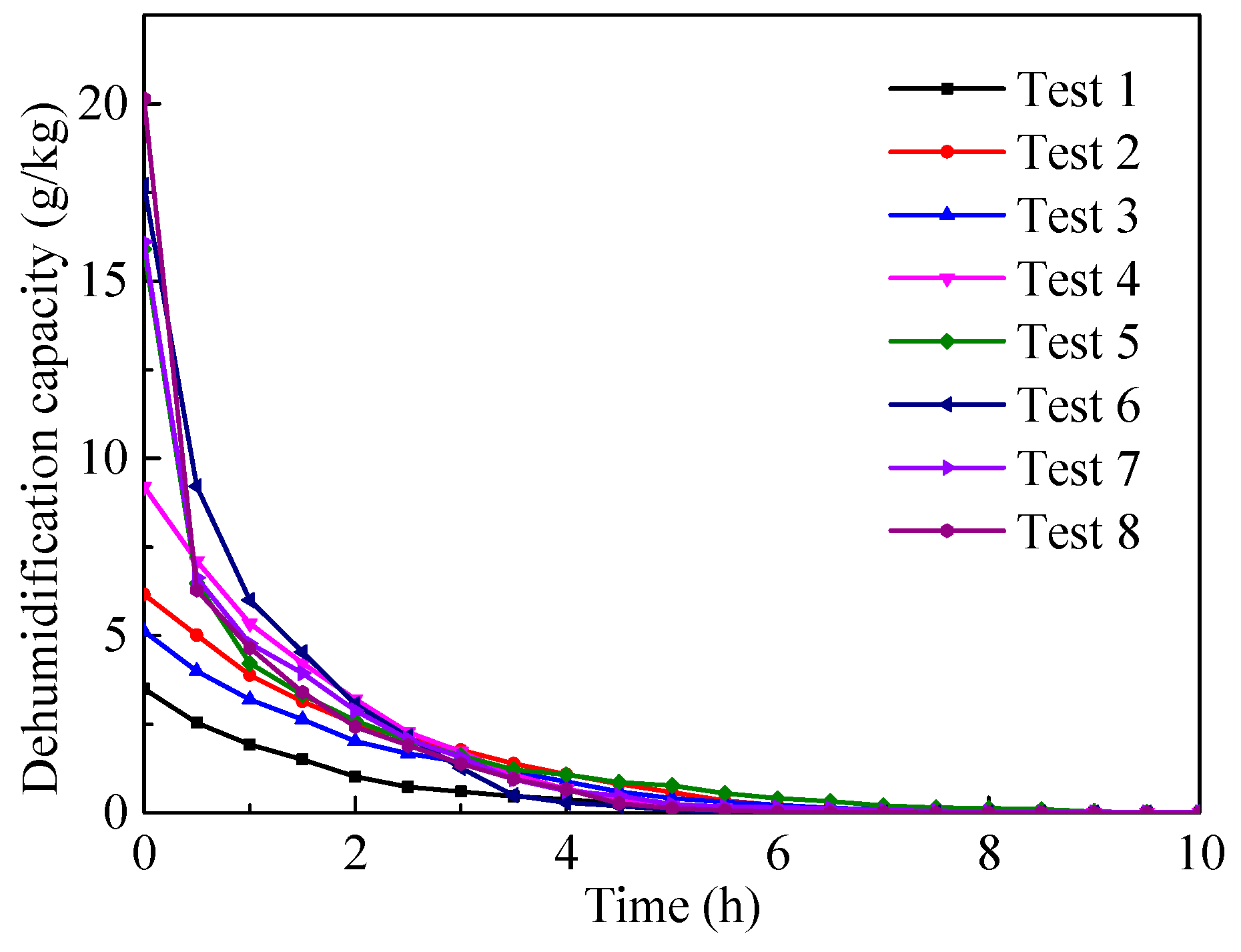
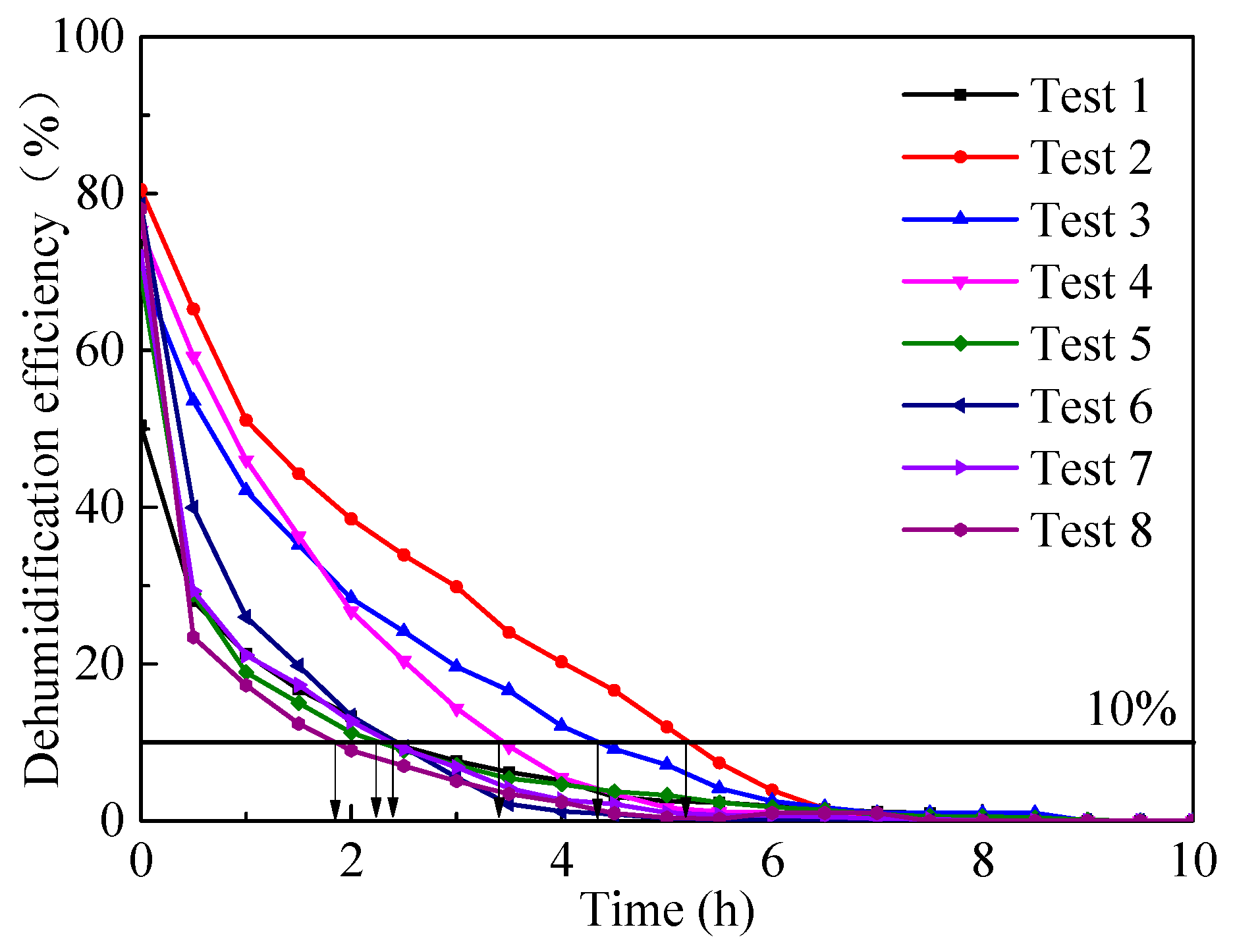
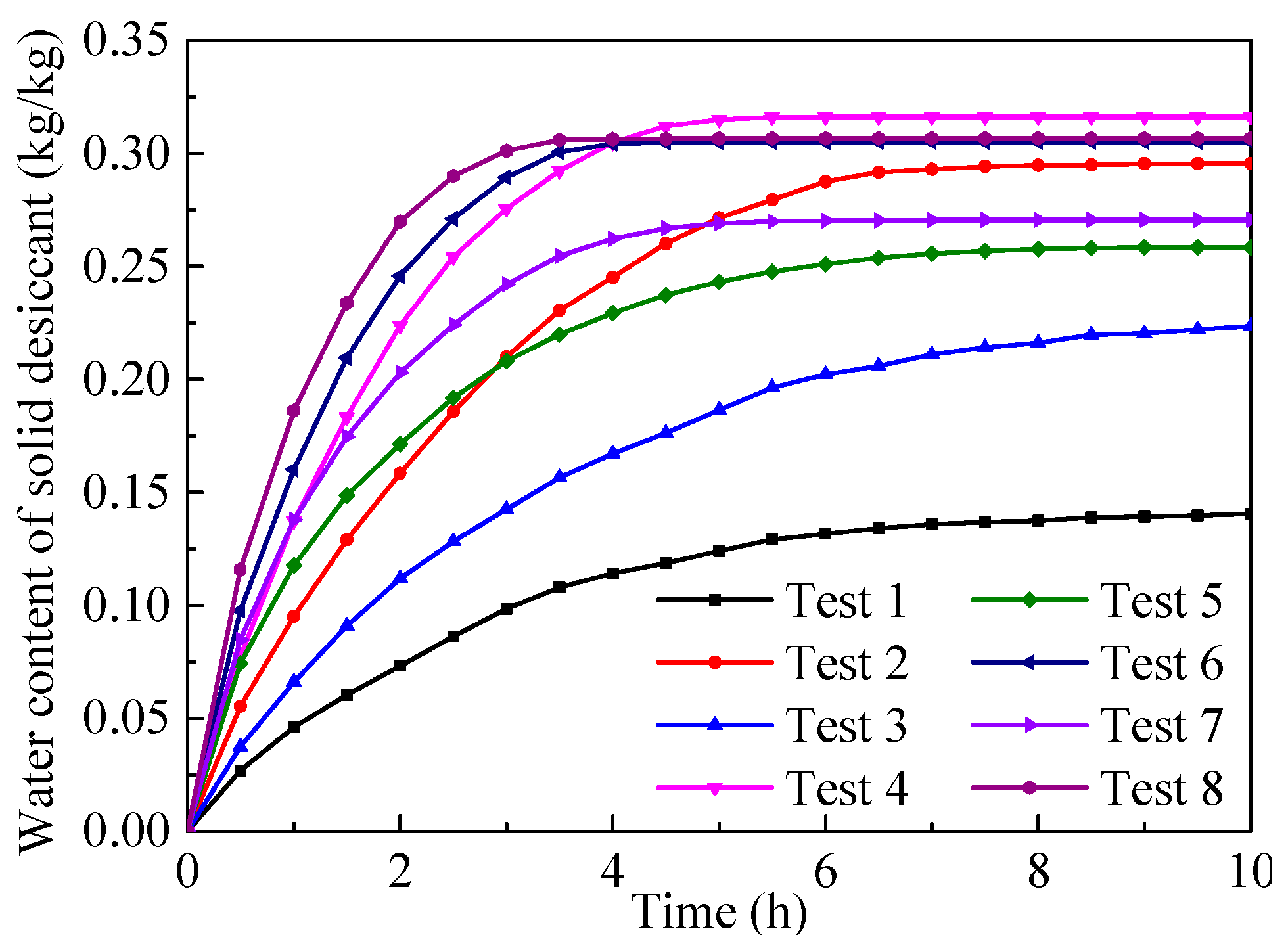
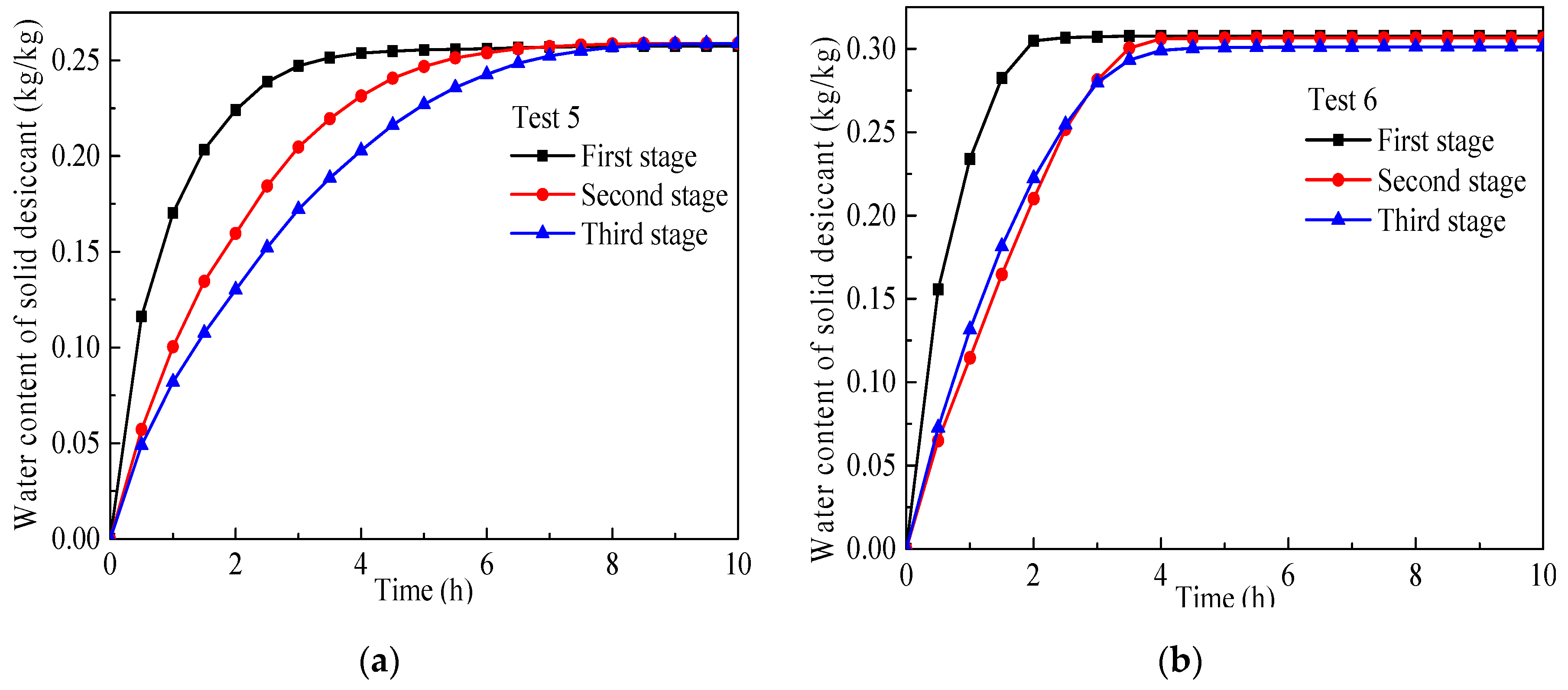

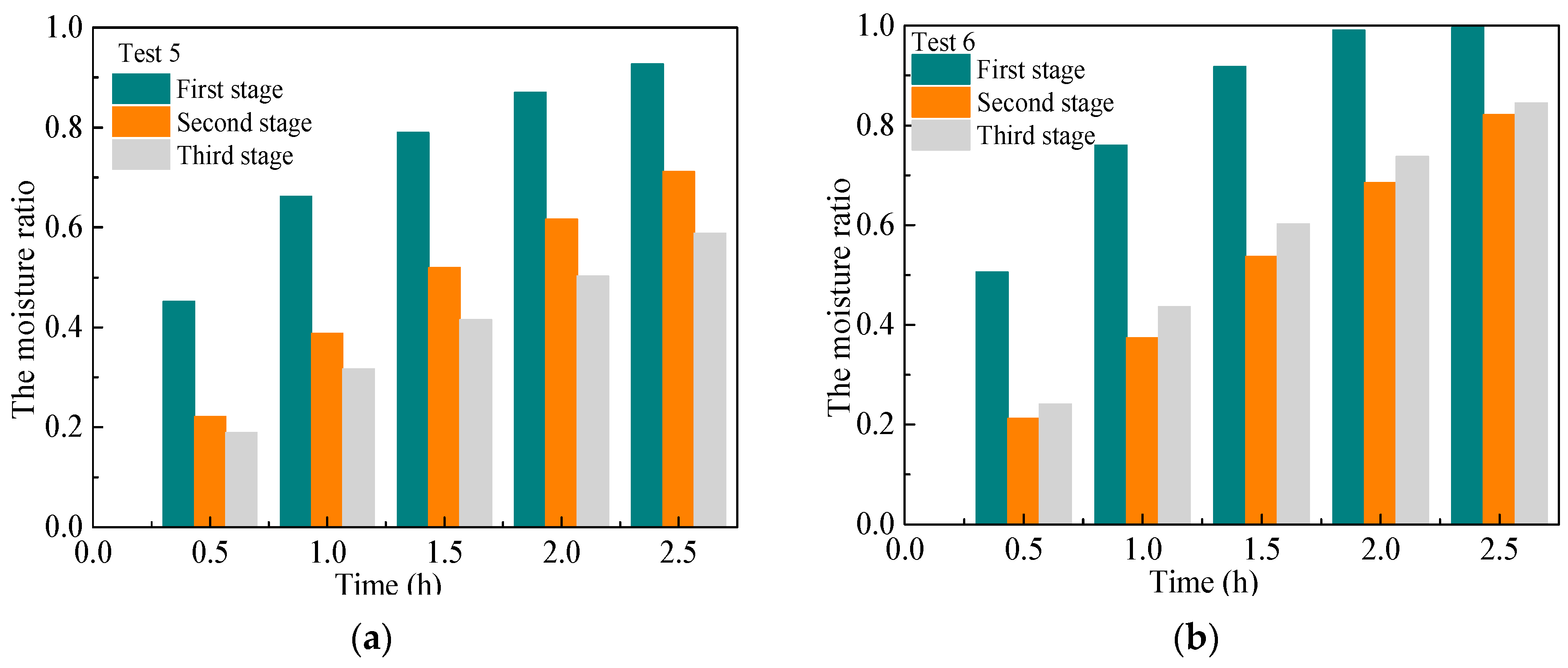
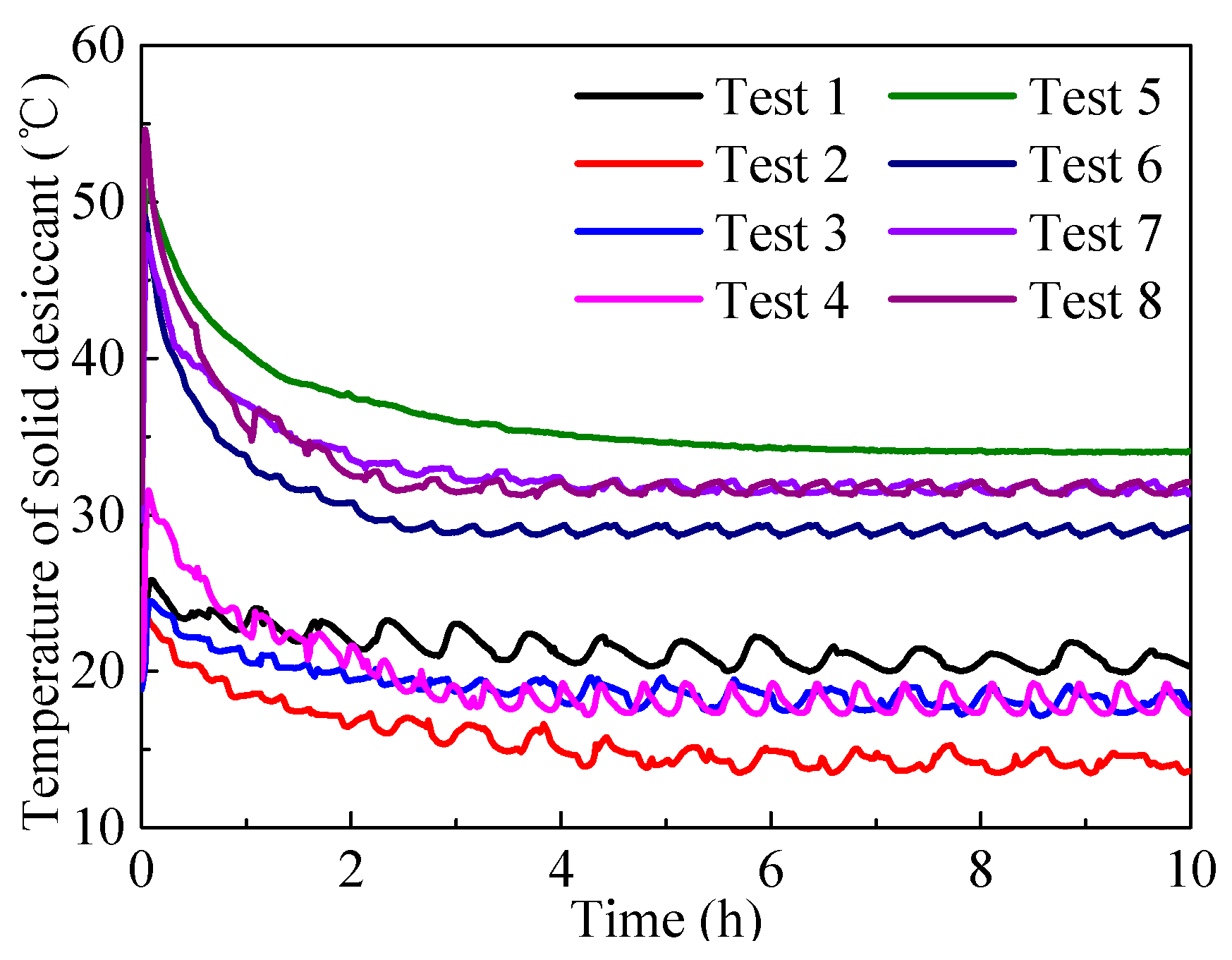

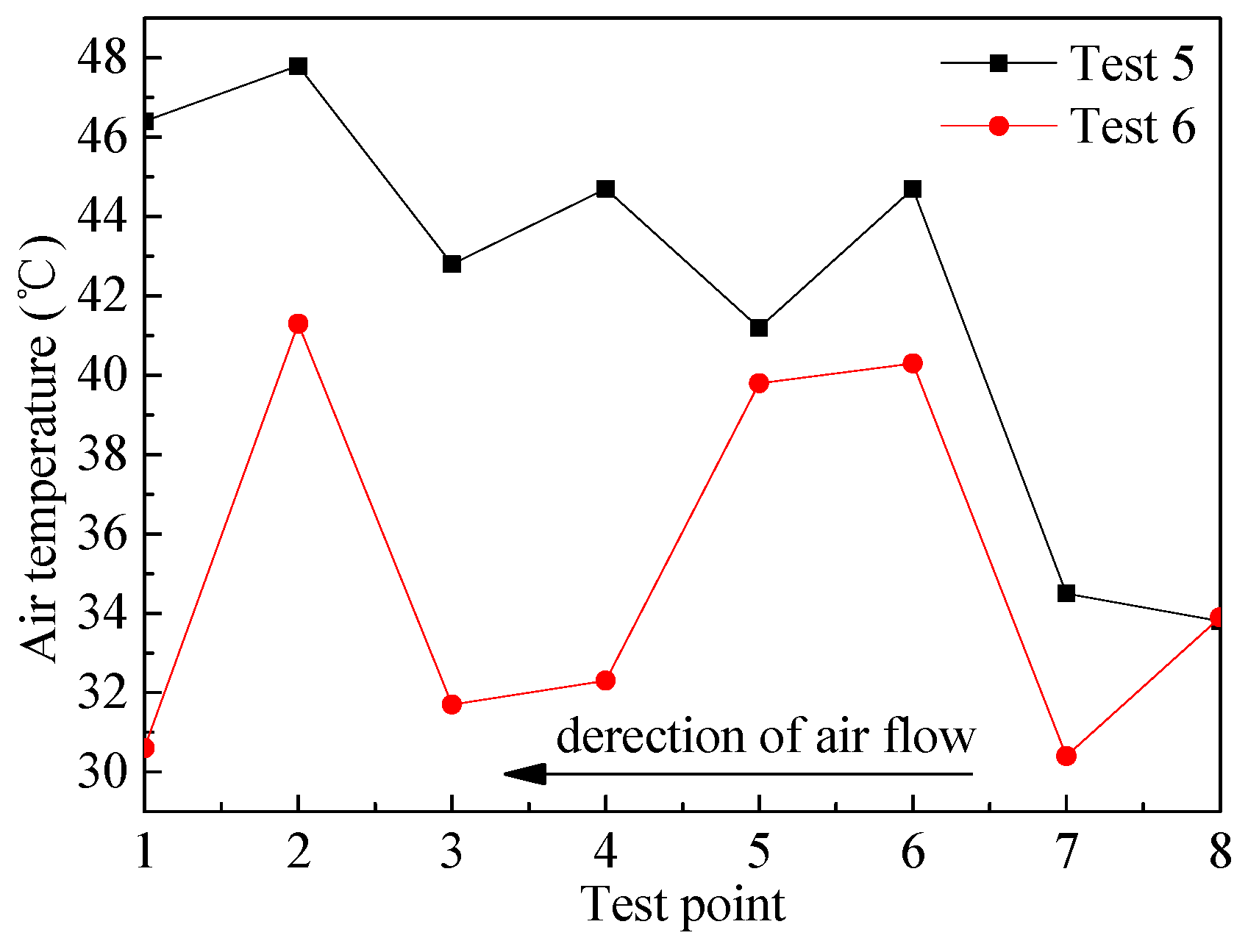
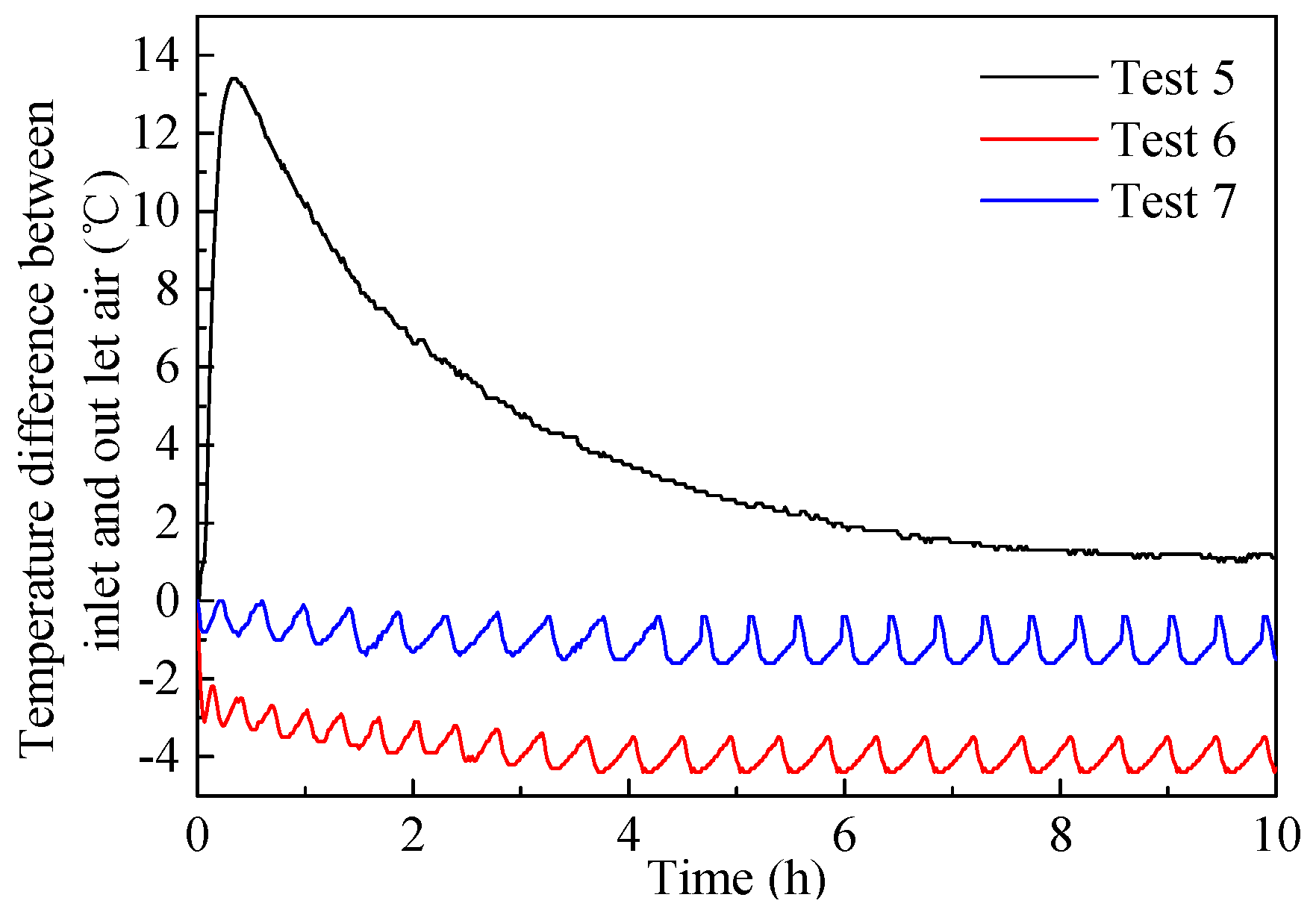
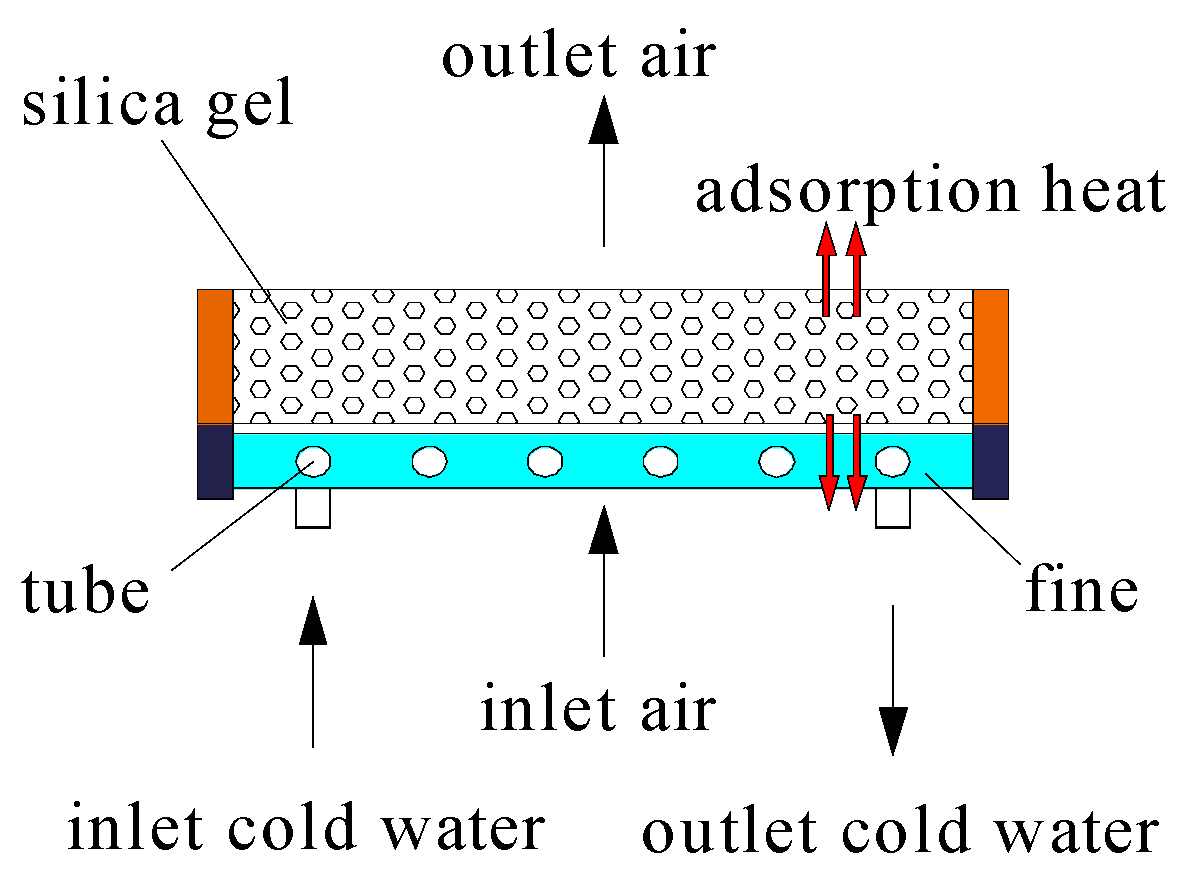
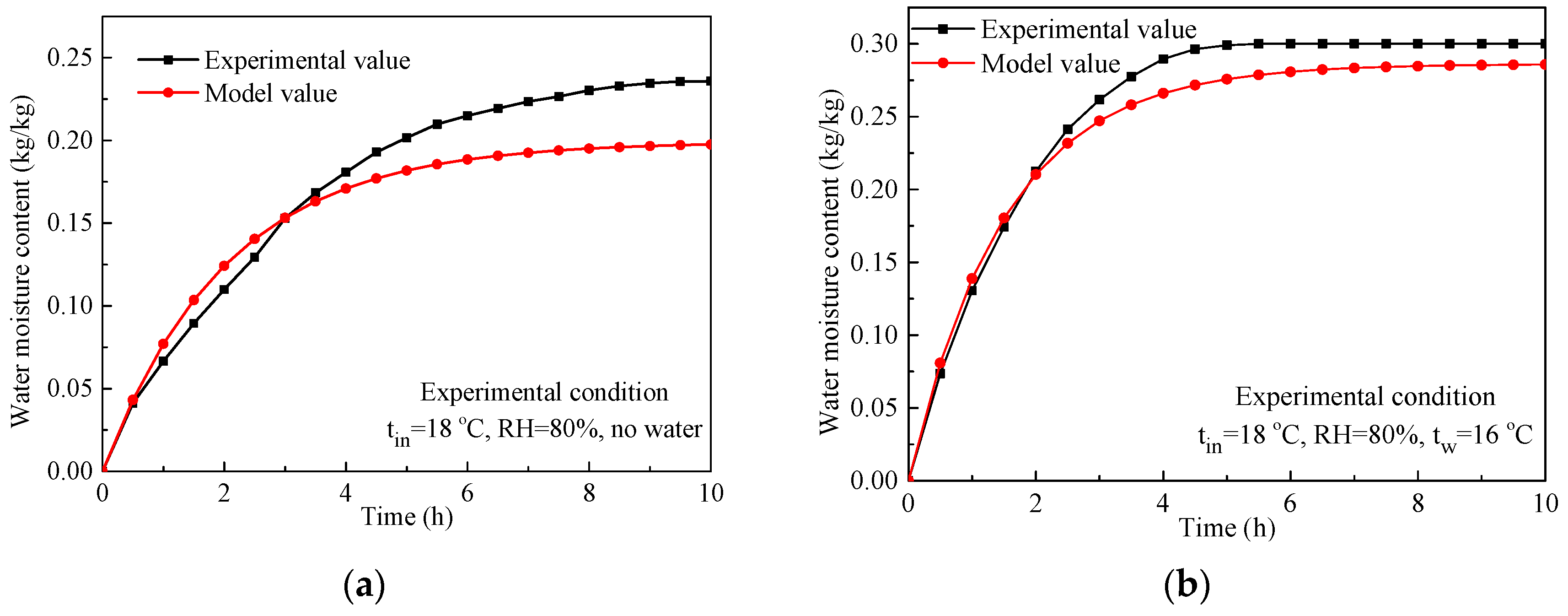
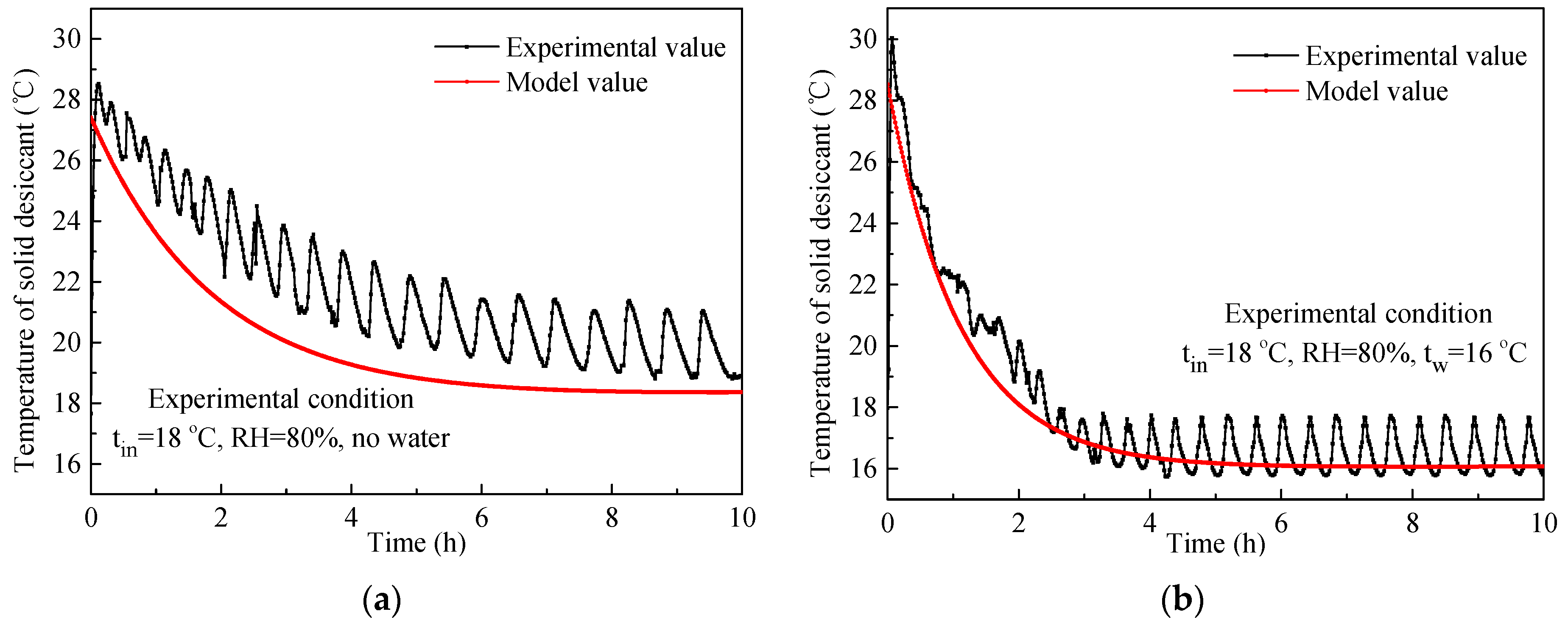
| Name | Type | Main Parameters |
|---|---|---|
| Environmental cabinet | TEMI1000 | Temperature range: −20–90 °C; accuracy: ±0.01 °C; relative humidity range: 0–85%; accuracy: ±0.1% |
| Multi-channel temperature and humidity monitor | PC-2WS | Accuracy: ±2% in humidity, ±0.2 °C in temperature |
| Multi-channel temperature logger | AT4364 | Sensor: K-type; accuracy: ± (value × 0.5% + 1) °C |
| Water chiller | - | Refrigerating capacity: 3 HP; power: 2250 W; accuracy: ±2 °C |
| Rotameter | LZS-15 | Range: 100 to 1000 L/h; accuracy: ±5% |
| Booster pump | CRS25-10 | Volume Flowrate: 80 L/h; lift: 10 m; power: 200 W |
| Self-priming pump | 1.5ZDK-20 | Volume Flowrate: 15 m3/h; lift: 20 m; suction: 8 m; power: 750 W |
| Fan | ASB20-4-1M | Mass flow rate: 486 m3/h; power: 190 W |
| Anemometer | TESTO 405-V1 | Range: 0 to 10 m/s; accuracy: 0.01 m/s |
| Electronic balance | JCS-A/C | Range: 0 to 3 kg; accuracy: 0.01 g |
| Electronic scale | TCS-01 | Range: 75 kg; accuracy: 2 g |
| Drying oven | DHG-9145A | Temperature range: 10–300 °C; accuracy: ±1.0 °C |
| Test No. | Water Temperature (°C) | Inlet Air Temperature (°C) | Inlet Air Humidity (%) | Humidity Capacity (g/kg) | Volume Flow of the Cold Water (L/h) | Wind Speed (m/s) |
|---|---|---|---|---|---|---|
| 1 | no water | 20 | 55 | 8.00 | — | 0.35 |
| 2 | 14 | 20 | 55 | 8.00 | 800 | 0.35 |
| 3 | 18 | 20 | 55 | 8.00 | 800 | 0.35 |
| 4 | 18 | 20 | 80 | 11.70 | 800 | 0.35 |
| 5 | no water | 34 | 68 | 23.04 | — | 0.35 |
| 6 | 28 | 34 | 68 | 23.04 | 800 | 0.35 |
| 7 | 32 | 34 | 68 | 23.04 | 800 | 0.35 |
| 8 | 32 | 34 | 80 | 27.28 | 800 | 0.35 |
| Test No. | 1 | 2 | 3 | 4 | 5 | 6 | 7 | 8 |
|---|---|---|---|---|---|---|---|---|
| Water content ratio (kg/kg) | 0.140 | 0.295 | 0.224 | 0.316 | 0.258 | 0.305 | 0.270 | 0.307 |
© 2018 by the authors. Licensee MDPI, Basel, Switzerland. This article is an open access article distributed under the terms and conditions of the Creative Commons Attribution (CC BY) license (http://creativecommons.org/licenses/by/4.0/).
Share and Cite
Yang, W.; Ren, J.; Lin, Z.; Wang, Z.; Zhao, X. Study on Dehumidification Performance of a Multi-Stage Internal Cooling Solid Desiccant Adsorption Packed Bed. Energies 2018, 11, 3038. https://doi.org/10.3390/en11113038
Yang W, Ren J, Lin Z, Wang Z, Zhao X. Study on Dehumidification Performance of a Multi-Stage Internal Cooling Solid Desiccant Adsorption Packed Bed. Energies. 2018; 11(11):3038. https://doi.org/10.3390/en11113038
Chicago/Turabian StyleYang, Wansheng, Jiayun Ren, Zhongqi Lin, Zhangyuan Wang, and Xudong Zhao. 2018. "Study on Dehumidification Performance of a Multi-Stage Internal Cooling Solid Desiccant Adsorption Packed Bed" Energies 11, no. 11: 3038. https://doi.org/10.3390/en11113038





